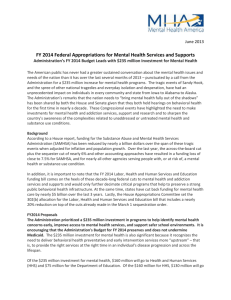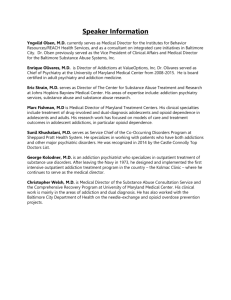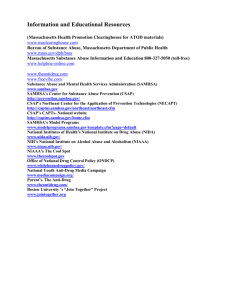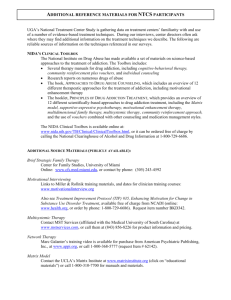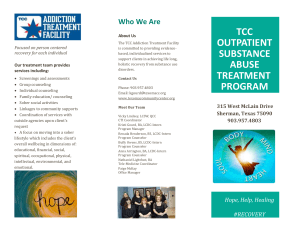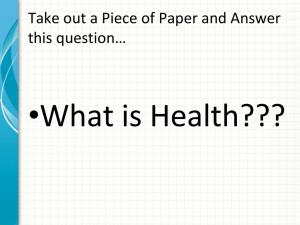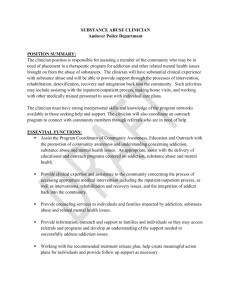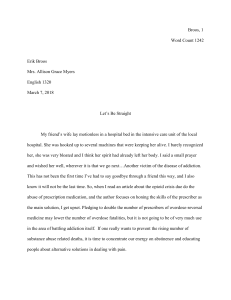3. Purpose
advertisement
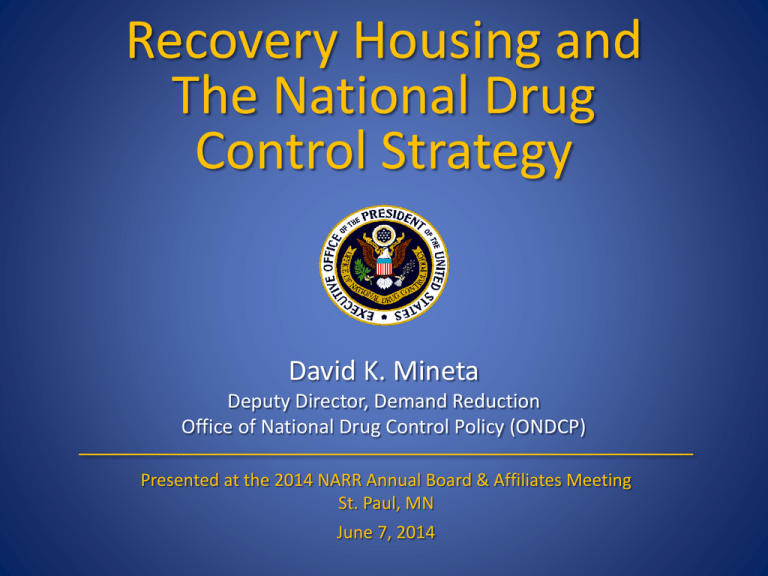
Recovery Housing and The National Drug Control Strategy David K. Mineta Deputy Director, Demand Reduction Office of National Drug Control Policy (ONDCP) Presented at the 2014 NARR Annual Board & Affiliates Meeting St. Paul, MN June 7, 2014 A st 21 Century Drug Policy • Stop drug use before it starts, and intervene early (prevention, early intervention) • Integrate with other sectors (primary care, campus health centers, etc.) using SBIRT • Expand access to treatment, including medication (buprenorphine, methadone, naltrexone) • Raise awareness of addiction and recovery • Expand access to recovery support services • Prevent & reverse overdose Housing in the National Drug Control Strategy • Expand access to recovery support services, including recovery housing. – Profiles of promising Public Housing Authority reentry programs, many including recovery housing, are in development. • Eliminate barriers to recovery, including Federal policies, rules, and practices that impede access to recovery housing and other recovery support services. The Need • In 2012, 22.2 million Americans aged 12 or older had a past year substance use disorder.1 • Nearly 1 out 5 (18.9 percent) of young adults aged 18 to 25 had a past year substance use disorder.1 • Long “addiction careers,” multiple episodes of treatment, and a median of nine years from first contact with public treatment system to one year of abstinence.2 • Overdose epidemic: More than 38,000 drug overdose deaths in 2010, approximately 22,000 involving RX drugs (76 percent of RX overdoses from opioids).3 1 SAMHSA (2013). Results from the 2012 National Survey on Drug Use and Health: Summary of National Findings. 2 Dennis, M.L. et al. (2007). The duration and correlates of addiction and treatment careers. Journal of Substance Abuse Treatment. 28 Suppl 1:S51-62. 3 CDC, 2012. National Center for Health Statistics. Multiple Cause of Death 1999-2010 on CDC WONDER Online Database. Extracted May 1, SAMHSA Recovery Framework Recovery Housing Supports All Four SAMHSA Dimensions of Recovery Dimensions of Recovery 1. Health: overcoming or 2. Home: a stable place to live. managing one’s disease(s) or symptoms—for example, abstaining from use of alcohol, illicit drugs, and non-prescribed medications … making informed, healthy choices. 3. Purpose: meaningful daily 4. Community: relationships and activities, such as a job, school, volunteerism, family caretaking, or creative endeavors, and the independence, income and resources to participate in society. social networks that provide support, friendship, love, and hope. Source of SAMHSA Dimensions: http://blog.samhsa.gov/2012/03/23/defintion-of-recovery-updated/ What We Know • Recovery housing (RH) produces positive outcomes: – Among residents of an RH linked with OP treatment, 68 percent were abstinent at 6 and 12 months, and 46 percent were abstinent at 18 months.1 – An RH-only model achieved 40 percent at 6 months , 45 percent at 12 months, and 42 percent at 18 months.2 • Research indicates that recovery housing can improve recovery outcomes: – Oxford House (OH) residence associated with abstinence from alcohol and drugs, improved employment and legal outcomes.3 – OH residents who stayed 6 months or more had significantly better outcomes than those who did not.4 – Recovery housing (RH) combined with RBT and RH alone produced significantly better outcomes than usual care among a sample of opioid dependent clients.5 1 Jason, L. et al. (2007). The need for substance abuse after-care: Longitudinal analysis of Oxford House. Addictive Behaviors. 32: 803-818. Jason, L. et al. (2007). An examination of main and interactive effects of substance abuse recovery housing on multiple indicators of adjustment. Addiction. 2007 July ; 102(7): 1114–1121. 3 Tuten, M. et al. (2012). Abstinence-Contingent Recovery Housing and Reinforcement Based Treatment Following Opioid Detoxification. Addiction. 107(5): 973–982. 4 Policin, D.L. et al. (2010). What Did We Learn from Our Study on Sober Living Houses and Where Do We Go from Here? Journal of Psychoactive Drugs. 42(4): 425–433. 5 Policin, D.L. et al. (2010). Sober Living Houses for Alcohol and Drug Dependence: 18-Month Outcomes. Journal of Substance Abuse Treatment. 38(4): 356-365. 2 What We Need to Know • What recovery housing (RH) models are currently in use? • What is the best way of classifying models for practical/clinical and research purposes? • What is the relative effectiveness of various RH models? • Can models be matched with populations? • What is the relative effectiveness and cost-effectiveness of RH offered in conjunction with various other services? • Is there a relationship between how RH is paid for and its effectiveness? • What our options for creating recovery housing in federally subsidized settings, such as public housing authorities. Challenges • Developing local & municipal government partners, communities, and neighborhoods. • Standards: – Staffing, physical plant/safety (building code), siting/zoning, owner operator requirements – Cost/reimbursement – NIMBYism • Expanding partnerships with CJS, state and local substance abuse and mental health authorities, and segments of health care system. • Developing and evaluating public and private reimbursement mechanisms. • Leveraging Federal housing programs to expand capacity. • Integrating people in medication-assisted treatment. Q & A / Discussion David K. Mineta Deputy Director, Demand Reduction Office of National Drug Control Policy dmineta@ondcp.eop.gov WhiteHouse.gov/ONDCP
